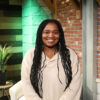90% of American Sign Language (ASL) interpreters are white, according to a 2018 report from the Registry of Interpreters for the Deaf. Last Saturday, a panel hosted by the Black Student Union (BSU) sought to raise awareness about the lack of interpreters of color and the challenges that they face.
Karen Horvath, an interpreting instructor at GC, said, “As a profession, there is a struggle to recruit and to grow the diversity of the interpreters who serve the Deaf community. There is simply a lack of numbers.”The panel, titled “Through Our Eyes,” included six Black interpreters, all of whom were women. They emphasized the importance of listening to the voices of Black and Brown individuals, African-American individuals and People of Color in the interpreting field to increase awareness and start conversations on the issue.
The panelists included Nakiya Weatherspoon, an interpreter who has worked for 20 years in various settings; Jasmine Baker, a current freelance interpreter of five years; Makayla Lowery, a senior in Bethel University’s interpreting program; Cynthia Norman, an interpreter of 36 years; and Isis Dixon, who has been interpreting for video relay services for 15 years.
The event was brought to fruition by Nakiyah Kilpatrick, BSU student leader and a junior ASL interpreting major at Goshen College.
Kilpatrick shared some concerns from her previous college’s interpreting program, which she saw resurfacing at GC, such as professors teaching racial slurs or dismissing her legitimate concerns.
“I was really upset one day with seeing the same issues through two [interpreting programs],” said Kilpatrick, “I talked to [GC students] who had graduated and who are currently going through the program, wondering ‘When is this going to change?’”
After voicing the matters to Dixon, her mentor, Kilpatrick said, “Let’s just create a panel, record it, and put it out in the world.”
Dr. LaKendra Hardware, the BSU advisor and director of diversity, equity and inclusion at GC, said, “It’s powerful anytime we can gather in community and hear experiences that are often off the radar.”
“It was eye-opening,” Hardware said, “to have to consider that to do the very thing [you chose] as your profession, you now have to also think about how to overcome the hurdle of your identity in a place where you’re not necessarily centered.”
The panelists have experience interpreting in various settings, from religious events to educational spaces. But each panel member spoke to their individual experiences regarding systematic racism and discrimination.
Norman spoke of her time as a mentor to Black students, saying, “I was finding a running theme that Black students in the [interpreting] program were being mishandled. They were not being supported. They were not being tutored.”
Panelists also brought up their experiences with white professors teaching racial slurs and microaggressions. Lowery expressed frustration at often being the “token Black person” until people in leadership became uncomfortable with her lived experience.
Many panelists expressed their unease regarding the prominent issue of attire in the interpreting field.
Interpreters are often told to wear colors that contrast with their skin. That is usually black or dark purples for lighter-skinned interpreters, whereas it is less clear for darker-skinned interpreters.
Kilpatrick noted that the blanket statements are not helpful: “When we ask for clarification,” she says, “the answer is typically [to wear] white.” Knowing how to apply the rule can be tough, and it’s an additional layer of nuance that Kilpatrick wishes professors would include.
BSU’s long-term goal is to host panels in other departments to promote the same level of growth and conversation. For now, there are some things they hope to see change.
Hardware said she hopes people challenge wrong ideas and think about action steps, even if they are not interpreting majors. “How can we as humanity be more aware of that and make sure that that’s not a norm going forward?”
Kilpatrick’s call to action is for the ASL program to implement and learn from the things panelists spoke about, such as forgoing the use of teaching racial slurs.
“I have been interpreting longer than many of my students have been alive,” said Horvath. “I have always said that when you stop trying to learn, you need to stop interpreting. This panel reinforces that statement.”



